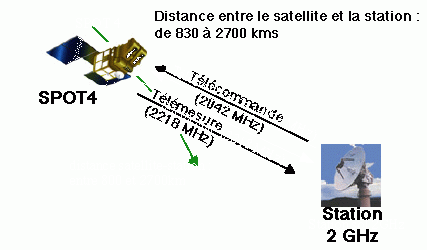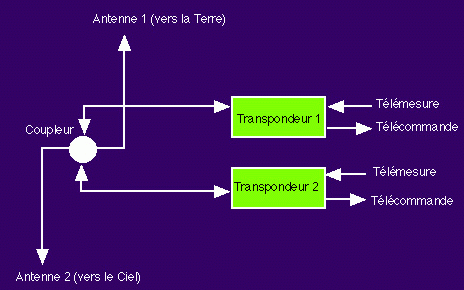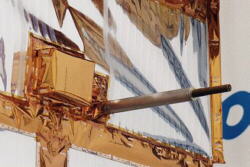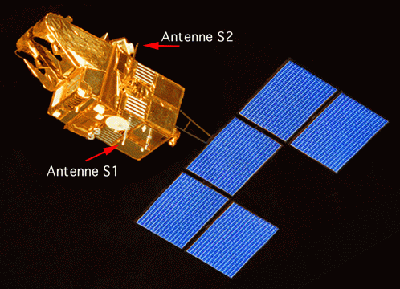 The
telemetry / command (TM/TC) link is the vital connection between the SPOT 4 satellite
and the operations control centre.
The
telemetry / command (TM/TC) link is the vital connection between the SPOT 4 satellite
and the operations control centre.What is the telemetry /
command link used for ?
Satellite
programming procedure ,
The TT&C network,
The satellite's ear,
Flight software
 The
telemetry / command (TM/TC) link is the vital connection between the SPOT 4 satellite
and the operations control centre.
The
telemetry / command (TM/TC) link is the vital connection between the SPOT 4 satellite
and the operations control centre.
It is used for communication between the satellite and the ground segment. Most of the time, the satellite operates automatically. Its orbit is such that it can only communicate with the ground segment 5 % of the time, when within range of a station in the TT&C network.
It is a "duplex" link (communication is two-way).
In one direction (satellite to ground), the link is used to monitor the satellite through status reports and anomalies detected by the onboard computer; this is telemetry. Telemetry is a set of measurements taken on board the satellite and then sent to the operations control centre. The measurements describe the satellite, subsystem by subsystem. Measurements concern magnitudes as varied as temperatures, voltages, currents etc. For example, if we consider the solar array subsystem, we need to know the output voltage and current at all times.
In the other direction (ground to satellite) the link is used either for routine programming (commercial imaging requested by Spot Image) or for sending commands to carry out specific actions to handle events as required (orbital manoeuvres, equipment tests, anomalies, failures etc.); this is the command link. Although modern satellites operate automatically, they still need to receive commands from the ground. This need is particularly obvious during the satellite attitude acquisition phase. During this critical phase, the satellite needs to be very closely controlled from the operations control centre. Once the solar arrays have been automatically deployed, commands sent by the control centre switch on the equipment that was off during the launch: recorders, payloads and passengers.
The same link is used for tracking. This term describes measurements taken to accurately locate the orbiting satellite (the correct term is orbit determination). This involves:
Once these measurements have been taken by the CNES TT&C network, they are sent on to the network's customer (in this case the operations control centre).
![]()
Each day, Spot Image groups together customer requests for regions of interest to be
acquired the following day.
It then sends the relevant workplan to the operations control centre.
The operations control centre checks the contents of the plan so as to avoid any damage to the satellite. It then converts the plan into commands ready to be sent to the satellite.
Telemetry and commands are exchanged with the satellite when it comes within range of
one of the TT&C network stations used by CNES.
Once "radio" contact has been made, the operations control centre receives the
housekeeping telemetry, translating it into parameters for display on the control
monitors. The operators are then able to interpret the parameters. Many of the parameters
are also analysed in real time by software in the operations control centre to assess the
satellite's health or draw up commands to be uplinked to the satellite during later
passes.
Rapidly, once the link has been established, and assuming that no anomalies are detected, the operations control centre sends the commands to the satellite as planned.
Apart from very rare, serious incidents, commands are prepared during the ten minute period before the pass and uploaded to the satellite before it goes out of range again (less than 15 minutes).
During this dialogue, the operations control centre in Toulouse is the "master". The "slave" (albeit relatively intelligent !) is the flight software on board the satellite. Communication between master and slave takes place using very high frequency radio waves (around 2 GHz) between the transmitting/receiving equipment on the satellite and each ground station in the CNES TT&C network.
![]()
The equipment is almost exactly the same as that used for ground stations:
 They
have the same modulation / demodulation functions for the 2 GHz frequency as the
ground segment. The transponders are very small. Each one transmits 250 mW telemetry
and receives command signals of infinitesimal power (measured in picoWatt: 10-12
Watt !). The transponders can pick up exceptionally weak signals.
They
have the same modulation / demodulation functions for the 2 GHz frequency as the
ground segment. The transponders are very small. Each one transmits 250 mW telemetry
and receives command signals of infinitesimal power (measured in picoWatt: 10-12
Watt !). The transponders can pick up exceptionally weak signals.
 The S1 antenna
The S1 antenna
 The
two transponders are coupled (they both receive the same signal and either one can
transmit, according to the configuration). Such "redundancy" ensures the system
has optimal reliability should one of the modules fail.
The
two transponders are coupled (they both receive the same signal and either one can
transmit, according to the configuration). Such "redundancy" ensures the system
has optimal reliability should one of the modules fail.
They are connected to both antennas at the same time via a hybrid coupler which distributes signals in both directions.
![]()
The flight software runs on a 12 MHz Fairchild 9450 processor (compared with the 100 to 200 MHz processor in your PC) and has a memory of less than 200 kbytes (far less than the 16 or 32 Mbytes of RAM in your computer). It is with such scanty resources that the flight software executes commands one after the other and handles satellite operating modes.
The satellite's daily tasks depend on the list of commands sent by the operations control centre. The flight software orders imagery acquisition according to customer requests when the satellite flies over the region of interest.
The flight software also carries out the orbit corrections needed to keep the satellite on the correct trajectory. It monitors all the satellite equipment by communicating with each subsystem. The monitoring takes place at 1 Hertz (once every second), 8 Hertz or 32 Hertz. It is designed so that the flight software can take any appropriate action necessary to guarantee that the satellite is not damaged. Should a fault be detected, the flight software continues to fulfil the vital satellite functions, calling upon backup equipment as required. The flight software is not required to locate the faulty part or to continue automatic imagery acquisition without the operations control centre's involvement. The software indicates the anomalies in the telemetry sent to the operations control centre and provides the experts in the Centre with all the information needed to locate the fault.
![]()
page updated on the 00-06-06